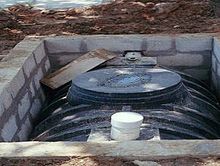Septic tank
Septic tanks can be coupled with other onsite wastewater treatment units such as biofilters or aerobic systems involving artificially forced aeration.[9] Another option is "scheduled desludging" of septic tanks which has been initiated in several Asian countries including the Philippines, Malaysia, Vietnam, Indonesia, and India.Some constituents of wastewater, especially sulfates, under the anaerobic conditions of septic tanks, are reduced to hydrogen sulfide, a pungent and toxic gas.This can be remedied by using a nitrogen-reducing technology,[18] such as hybrid constructed wetlands, or by simply ensuring that the leach field is properly sited to prevent direct entry of effluent into bodies of water.[citation needed] The fermentation processes cause the contents of a septic tank to be anaerobic with a low redox potential, which keeps phosphates in a soluble and, thus, mobilized form.[20] A properly functioning septic system, on the other hand, provides significant reduction of pathogens compared to direct discharge due to settling (in the tank) and soil absorption (in the drain field).To reduce residential development that might increase the demand to construct an expensive centralized sewerage system, building moratoriums and limitations on the subdivision of property are often imposed.Ensuring existing septic tanks are functioning properly can also be helpful for a limited time, but becomes less effective as a primary remediation strategy as population density increases.In the United States, the 2008 American Housing Survey indicated that about 20 percent of all households rely on septic tanks,[22] and that the overwhelming majority of systems are located in rural (50%) and suburban (47%) areas.Part 1 (EN 12566-1) is for septic tanks that are prefabricated or factory manufactured and made of polyethylene, glass reinforced polyester, polypropylene, PVC-U, steel or concrete.Certified septic tanks of both types must pass a standardized hydraulic test to assess their ability to retain suspended solids within the system.[24] In France, about 4 million households (or 20% of the population) are using on-site wastewater disposal systems (l’assainissement non collectif),[25] including septic tanks (fosse septique).[26] Septic tanks in France are subject to inspection by SPANC (Service Public d’Assainissement Non Collectif), a professional body appointed by the respective local authorities to enforce wastewater collection laws, at least once in four years.[35] In Australia, septic tank design and installation requirements are regulated by State Governments, through Departments of Health and Environmental Protection Agencies.[citation needed] According to the US Environmental Protection Agency, in the United States it is the home owners' responsibility to maintain their septic systems.[40] Anyone who ignores this requirement will eventually experience costly repairs when solids escape the tank and clog the clarified liquid effluent disposal system.The district provides a mechanism to generate local funds for water quality services to control non-point sources of pollution, such as septic system maintenance.





Septic Tank (band)blackwater (waste)greywaterFecal sludgeeffluentGroundwater pollutionwater pollutionsewagesewage treatmentanaerobic digestiononsite sewage facilitysewerageseptic drain fieldanaerobic bacterialonsite wastewater treatmentbiofiltersaerationseptagevacuum truckwastewaterpercolation testpercolationevaporationplantstranspirationgroundwatersurface waterweeping tilesiphonsbiocloggingImhoff tankFecal sludge managementcigarette buttscotton buds/swabscondomsfood wastepesticidesherbicidesbleachcaustic sodawater softenerssnowmeltfloodingwater tablesbiofilmsPit additiveeffective microorganismsdrainfieldssulfateshydrogen sulfidepungentNitratesorganic nitrogen compoundsammoniafermentationcarbon dioxidemethanenitrogenalgal bloomsphosphatescyanobacteriaseptic drain fieldseutrophicationE. colicoliform bacteriaLog reductionssubdivisionshellfishUnited StatessuburbanIndianapolisEuropean UnionEN 12566polyethylenepolypropyleneconcreteFranceCensus of Ireland 2011European Court of JusticeIrelandWaste Framework DirectiveEnvironmental Protection AgencyEnglandEnvironment AgencyNorthern IrelandDepartment of the EnvironmentScotlandSunshine Coast, QueenslandUS Environmental Protection AgencyWashingtonrhyming slangCesspitGrease trapSanitationOff-the-gridThe World BankUnited States Environmental Protection AgencyM. GumpertzWayback MachineWATE-TVAcid mine drainageBallast waterBathroomBlackwater (coal)Boiler blowdownCombined sewerCooling waterInfiltration/InflowLeachateManureProduced waterReturn flowSanitary sewerSewage sludgeToiletUrban runoffQuality indicatorsAdsorbable organic halidesBiochemical oxygen demandChemical oxygen demandColiform indexOxygen saturationHeavy metalsSalinityTemperatureTotal dissolved solids